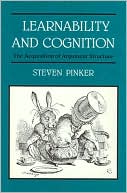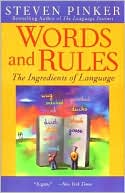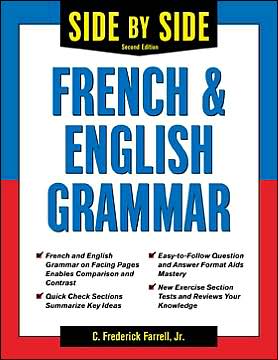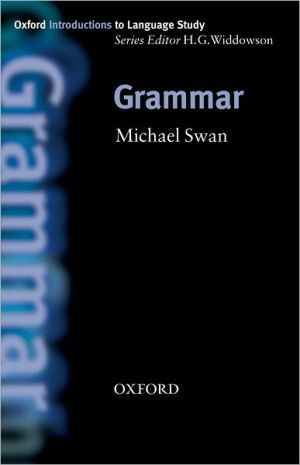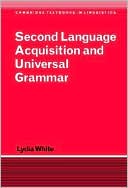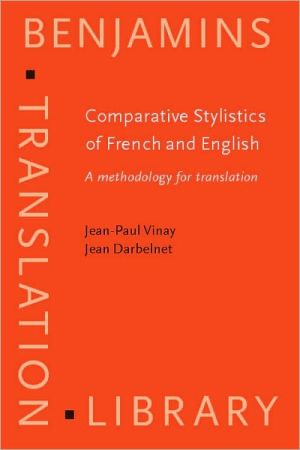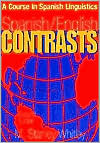Learnability and Cognition: The Acquisition of Argument Structure
Search in google:
In tackling a learning paradox that has challenged scholars for more than a decade, Pinker synthesizes a vast literature in linguistics and psycholinguistics and outlines explicit theories of the mental representation, learning, and development of verb meaning and verb syntax.
Series ForewordAcknowledgmentsA Learnability Paradox1.1 Argument Structure and the Lexicon1.2 The Logical Problem of Language Acquisition1.3 Baker's Paradox1.4 Attempted Solutions to Baker's Paradox1.4.1 Components of the Paradox1.4.2 Solution #0: Nonsolutions1.4.3 Solution #1: Variants of Negative Evidence1.4.3.1 Subtle Negative Evidence1.4.3.2 Nonoccurrence: A Surrogate for Negative Evidence?1.4.3.3 Uniqueness: Another Surrogate for Negative Evidence?1.4.4 Solution #2: Strict Lexical Conservatism1.4.4.1 Evidence Against Strict Lexical Conservatism in Children: Spontaneous Speech1.4.4.2 Evidence Against Strict Lexical Conservatism in Children: Experiments1.4.5 Solution #3: Syntactic Representations as Criteria for the Application of Lexical Rules1.4.5.1 Representations for Argument Structures1.4.5.2 Using Properties of Syntactic Representations to Solve the Learning Problem1.4.5.3 Obligatory Versus Optional Arguments1.4.5.4 Arguments Versus Nonarguments1.4.5.5 Unaccusativity1.4.5.6 Other ProposalsConstraints on Lexical Rules2.1 Morphological and Phonological Constraints2.2 Semantic Constraints2.2.1 Dative2.2.2 Causative2.2.3 Locative2.2.4 Passive2.3 How Semantic and Morphological Constraints Might Resolve Baker's Paradox2.4 Evidence for Criteria-Governed Productivity2.5 Problems for the Criteria-Governed Productivity TheoryConstraints and the Nature of Argument Structure3.1 Overview: Why Lexical Rules Carry Semantic Constraints3.2 Constraints on Lexical Rules as Manifestations of More General Phenomena3.2.1 Constraints on Argument Structures ThatAre Independent of Lexical Rules3.2.2 Constraints on Grammatical Functions That Are Independent of Particular Argument Structures3.2.3 Constraints on Verb Choice Are Also Constraints on Interpretation3.3 A Theory of Argument Structure3.3.1 Background Assumptions3.3.2 Semantic Conflation Classes as Thematic Cores of Argument Structures3.3.3 Linking Rules3.3.4 Lexical Rules3.3.4.1 The Locative Alternation3.3.4.2 The Dative Alternation3.3.4.3 The Causative Alternation3.3.4.4 The Active-Passive Relation3.4 On UniversalityPossible and Actual Forms4.1 The Problem of Negative Exceptions4.1.1 Why the Negative Exceptions Exist4.2 Transitive Action Verbs as Evidence for Narrow Subclasses4.3 The Nature of Narrow Conflation Classes4.4 Defining and Motivating Subclasses of Verbs Licensing the Four Alternations4.4.1 Dativizable Verbs4.4.1.1 The Morphological Constraint on the Dative4.4.2 Locativizable Verbs4.4.3 Causativizable Verbs4.4.4 Passivizable Verbs4.4.4.1 Passivizable Action Verbs4.4.4.2 The Thematic Relations Hypothesis Extended to Agent-Patient Relations4.4.4.3 Passivizable Abstract and Stative Verbs4.4.4.4 Other Passivizable Verbs Lacking Concrete Agents and Patients4.4.4.5 What Makes the Passive Different from Other Alternations?4.5 The Relation Between Narrow-Range and Broad-Range Rules4.5.1 Ungrammatical Uses of Lexical Rules in Adult Language4.5.2 Property-Predicting Versus Existence-Predicting Rules4.5.3 Why Are Only Narrow-Range Rules Existence-Predicting?Representation5.1 The Need for a Theory of Lexicosemantic Representation5.2 Is a Theory of Lexical Semantics Feasible?5.2.1 Skepticism About Decompositional Theories of Word Meaning5.3 Evidence for a Semantic Subsystem Underlying Verb Meanings5.4 A Cross-linguistic Inventory of Components of Verb Meaning5.5 A Theory of the Representation of Grammatically Relevant Semantic Structures5.5.1 Conceptual Constituents and Functions for Motion Events5.5.2 Interfacing Semantic Structures with Syntax5.5.3 Manner of Motion5.5.4 States5.5.5 Properties5.5.6 Extension to Nonlocational Semantic Fields5.5.7 Actions, Agents, and Patients5.5.8 A Possible Featural Representation for Basic Predicates5.5.9 Interevent Relations: Effects, Means, and Coreference5.5.10 Linking Oblique Arguments5.5.11 A Family of Causal Relations5.5.12 Nonphysical Semantic Fields for Acts5.5.13 Temporal Information5.5.14 A Remark on Redundancy, Constraints, and Decomposition5.5.15 Summary of Semantic Machinery5.6 Explicit Representations of Lexical Rules and Lexicosemantic Structures5.6.1 Representations for the Dative5.6.2 Representations for the Causative5.6.3 Representations for the Locative5.6.4 Representations for the Passive5.7 SummaryLearning6.1 Linking Rules6.1.1 Problems with Using Innate Linking Rules6.1.1.1 Can Linking Rules Form Vicious Circles in Acquisition?6.1.1.2 Syntactic Ergativity6.2 Lexical Semantic Structures6.2.1 Event-Category Labeling6.2.2 Semantic Structure Hypothesis Testing6.2.3 Syntactic Cueing of Semantic Structures6.3 Broad Conflation Classes (Thematic Cores) and Broad-Range Lexical Rules6.4 Narrow Conflation Classes and Narrow-Range Lexical Rules6.4.1 Why Lexical Abstraction Doesn't Work6.4.2 Clustering Algorithms and Classwise Indirect Negative Evidence: Would They Work?6.4.3 Parameterization of Idiosyncratic Lexical Information6.4.3.1 Key Facts About Narrow Classes and Rules6.4.3.2 A Strong Hypothesis for Narrow-Range Rule Formation6.4.3.3 Learning the Variable Ranges of Rules by Focusing on the Changing Arguments6.4.3.4 Other Ways of Preventing the Rules from Being Too Narrow6.5 Summary of Learning MechanismsDevelopment7.1 Developmental Sequence for Argument Structure Alternations7.1.1 Early Conservative Usage Preceding Onset of Errors7.1.2 Overapplication of Argument Structure Alternations7.1.3 Progression Toward the Adult State7.2 The Unlearning Problem7.2.1 A Simple Solution to the Unlearning Problem7.2.1.1 Why Children Would Sound Different from Adults Even If the Minimalist Solution Is Correct7.3 Children's Argument Structure Changing Rules Are Always Semantically Conditioned7.3.1 Semantic Constraints on Children's Causatives7.3.1.1 Experimental Evidence7.3.1.2 Are Productive Transitives in Spontaneous Speech Necessarily Causative?7.3.1.3 Choice of Causativized Predicates and Arguments in Causative Errors7.3.1.4 Causativization of Transitive Verbs7.3.2 Semantic Constraints on Children's Datives7.3.2.1 Experimental Evidence7.3.2.2 Spontaneous Speech7.3.3 Semantic Constraints on Children's Locatives7.3.3.1 Experimental Evidence7.3.3.2 Spontaneous Speech7.3.4 Semantic Constraints on Children's Passives7.3.4.1 Experimental Evidence7.3.4.2 Spontaneous Speech7.3.5 Summary of Semantic Constraints on Children's Lexical Rules7.4 Do Children's Errors Have the Same Cause as Adults'?7.4.1 Overall Tendency Toward Conservativism7.4.1.1 Experimental Evidence for Conservative Tendencies7.4.1.2 Conservative Tendencies in Spontaneous Speech7.4.2 Evidence That Children Are Ambivalent About Their Own Errors7.4.3 Summary of Differences Between Children's Errors and Adults'7.5 Acquisition of Verb Meaning and Errors in Argument Structure7.5.1 The Development of Verb Meaning7.5.1.1 Later Onset and Slower Rate7.5.1.2 Underspecified meanings7.5.1.3 Overspecified meanings7.5.1.4 Biases in Semantic Development7.5.1.5 Substitution Errors7.5.2 Relations Between the Development of Verb Meaning and the Development of Argument Structure7.5.2.1 Onset of Errors7.5.2.2 Argument Structures in Verb Substitution Errors7.5.2.3 Relations Between Biases in Acquiring Verb Semantics and Recurring Errors in Argument Struct...7.5.3 Experimental Evidence Showing That Semantic Biases Affect Argument Structures7.5.3.1 Errors in Understanding Fill-type Verbs7.5.3.2 Semantic and Syntactic Errors with Fill-type Verbs in the Same Children7.5.3.3 Effects of the Semantics of Newly Learned Verbs7.6 Some Predictions About the Acquisition of Narrow-Range Rules7.6.1 A Speculation About the Role of Maturation7.7 Summary of DevelopmentConclusions8.1 A Brief Summary of the Resolution of the Paradox8.2 Argument Structure as a Pointer Between Syntactic Structure and Propositions: A Brief Comparison...8.3 The Autonomy of Semantic Representation8.4 Implications for the Semantic Bootstrapping Hypothesis8.5 Conservatism, Listedness, and the Lexicon8.6 Spatial Schemas and Abstract ThoughtReferencesNotesIndex
